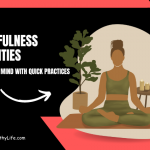
Image Source: Pixabay
Panic attacks can strike out of the blue regardless of whether the person has a history of anxiety or not. And they can be a scary experience… the symptoms are often similar to those of a heart attack:
- Palpitations
- tightness in the chest
- sweating
In addition, you may find yourself unable to breathe and feel your chest walls caving in; every breath may feel as if it’s your last one. Sufferers may also experience light-headedness and a scary feeling of suffocation. The pain in the chest is not imagined – it’s quite real but the difference is that your chest muscles (and not the heart) hurt due to erratic, labored breathing.
Panic attacks have the power to leave us feeling completely unnerved and anxious. However, the good news is that panic attacks can be effectively managed by using some simple, natural techniques without the need for medication. While medication is an option, there is often associated side-effects like drowsiness and sexual dysfunction.
Panic attacks are often cause for concern for those of us who suffer from chronic anxiety, constantly fearing an unexpected attack that may come on at any moment. This can leave you feeling uneasy, restless and anxious. Constant worry about an impending panic attack can even prompt us to avoid certain situations, such as social gatherings, using public transport or even at work. When that level of anxiety hits, you may feel that you’ve lost control over your own mind and can start feeling trapped.
It’s at this point that you need to regain control and start taking proactive measures to ensure you can confidently handle yourself in an uncomfortable situation that you might find worrying about an impending panic attack. It’s important to realize that chronic anxiety cannot simply be wished away. By following the preventative techniques explained below, you can manage panic attacks without feeling overwhelmed and out of control, and start living life on your own terms again.
1. Focus on your Breathing
One of the most effective ways to stave off panic attacks is to calm your mind and become consciously aware of your sensations of anxiety. A good way to do this is by practicing diaphragmatic breathing. This form of breathing involves breathing from your belly. Try imagining that you have a balloon in your stomach and take longer to exhale than to inhale. For example, you can ideally try inhaling for 3 seconds and exhaling for 4 seconds.
Do this for ten repetitions, focusing only on your breathing and nothing else. This technique is extremely effective in calming the mind and bringing you back to a normal state by reducing your panic attack symptoms.
2. Progressive muscle relaxation
Another way to relax your mind and body is by practicing what is known as progressive muscle relaxation.
Often we’re not aware that our muscles have grown stiff as we are holding in the tension. If possible, lie down on the floor with your arms by your side or sit in a comfortable chair. Now close your eyes and tighten the muscles in your feet and gently relax them after 3 to 4 seconds. Keep them relaxed for 20 to 30 seconds. Repeat this with muscles in your calves, knees, thighs, pelvis, stomach, arms and neck and so on. Inhale when you tighten them and exhale when you release the muscles.
By focusing only on your muscles contracting and relaxing, this strategy will quickly help you relax and reduce your feelings of panic and anxiety.
3. Practice Visualisation
The third way to manage panic attacks is by practicing visualization. Close your eyes and imagine yourself in a relaxing scenario like a garden or on the beach. Think about the gentle, lapping sound of waves and feel the warm sunshine on your back. Breathe gently and concentrate on the sounds, smells, sights and sensations that you experience in your mind. Creative imagery helps calm down stressful thoughts.
The great thing about this relaxation technique is that you don’t need any equipment, and you can do it literally anywhere – at your desk, in your living room and even on public transport, which makes it a very valuable method of calming yourself and preventing the onset of a panic attack.
4. Mindfulness
The fourth effective method involves being consciously mindful of the symptoms of the panic attack as it occurs. Observe your symptoms and acknowledge them without getting caught up in your fears. Allow the thoughts to drift into your mind and let it go without judgment or engagement. This technique is known as mindfulness meditation and is very effective in managing panic attacks.
It’s a good idea to limit your intake of caffeine as it stimulates your fight or flight response. People vulnerable to anxiety or panic attacks may wish to limit their intake of tea, chocolate, coffee and sodas, and alcohol.
You can also build confidence and trust in yourself by reminding yourself of difficult situations and how you overcame them. Learning to trust in yourself helps you manage deep-seated fears and anxieties that lie at the root of panic attacks.
Conclusion
The next time you’re feeling anxious and wary of a panic attack coming on, keep in mind these four super effective and simple ways of bringing yourself back from the edge, and you’ll be much better prepared for managing an oncoming panic attack.
By Greg Redmond, Director Counselling in Melbourne, 2018
This article is for general educational purposes only and should not be relied upon as a substitute for individual professional advice, diagnosis, or treatment. If you need help for an emotional or behavioral problem, please seek the assistance of a psychologist or other qualified mental health professional.


![[Infographic] Identifying a Panic Attack Infographic-F](https://www.safeandhealthylife.com/wp-content/uploads/2023/10/Infographic-F-150x150.webp)

![[Infographic] A Quick & Easy Guide On Maternity Leave For Surrogate Mothers Maternity-Leave-For-Surrogate-Mothers](https://www.safeandhealthylife.com/wp-content/uploads/2023/10/Maternity-Leave-For-Surrogate-Mothers-1-150x150.webp)